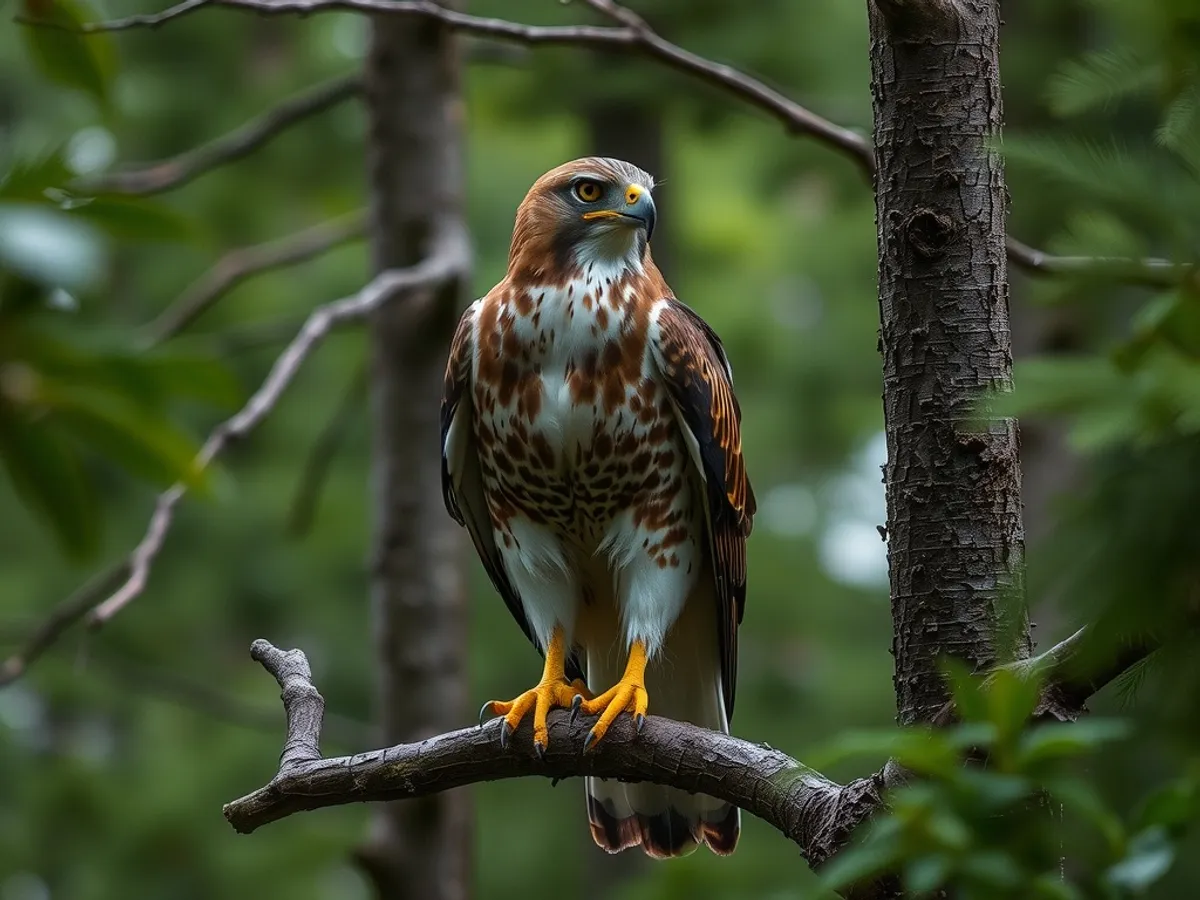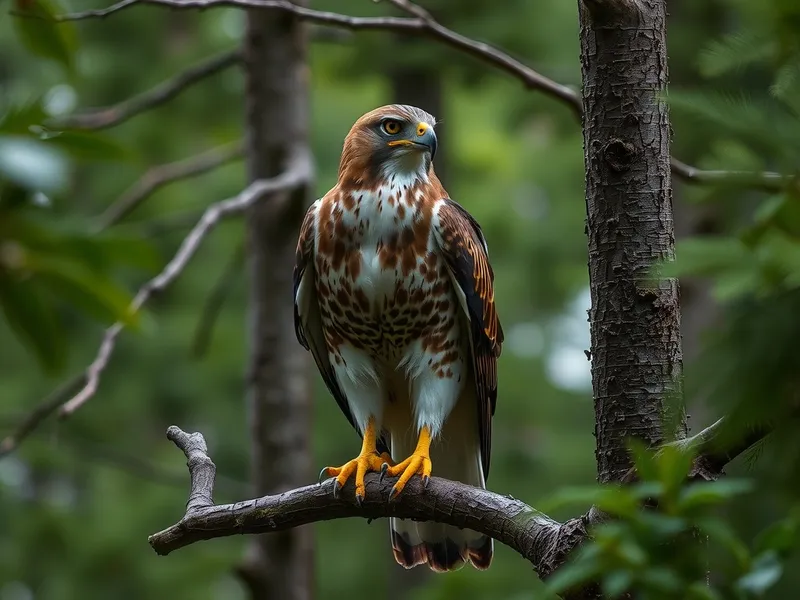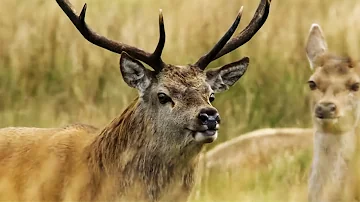
Northern Goshawk
Accipiter gentilis

Meet the Northern Goshawk
The Northern Goshawk is a large and powerful bird of prey known for its fierce hunting skills and broad, rounded wings. It is recognized by its slate-gray upperparts, pale underparts with fine barring, and striking red eyes in adults. This raptor is highly adaptable, inhabiting dense forests across much of the Northern Hemisphere, where it stealthily pursues birds and mammals. Agile and fast, the goshawk is capable of spectacular flight maneuvers even in thick woodland. It is revered in many cultures for its prowess and has been used in falconry for centuries.
Classification
Bird
Habitat
Temperate and boreal forests
Diet
Carnivore
Lifespan
10-15 years in the wild
Conservation
Least Concern
Weight
0.7–1.4 kg
📖Fascinating Facts
A Master of Maneuvering
The Northern Goshawk's short, broad wings and long tail allow it to weave through dense forests with incredible agility while hunting.
Protective Parents
Goshawks are fiercely territorial during breeding season and will aggressively defend their nests from intruders, including humans.
Forest Specialist
They prefer large, mature forests for nesting, often building their large stick nests high in the trees, which they may reuse or refurbish year after year.
📋Detailed Description
The Northern Goshawk is a robust, medium-to-large raptor, with adults typically measuring 55–61 cm in length and exhibiting a wingspan of 98–115 cm. Females are larger than males, a form of sexual dimorphism common in raptors, with females weighing 820–1,360 g and males 630–1,100 g. The plumage is characterized by slate-gray to blue-gray upperparts and pale underparts heavily barred with fine gray lines; juveniles display brown upperparts and streaked underparts. The species possesses a prominent white supercilium (eyebrow) above striking red or orange eyes in adults, while juveniles have yellowish eyes. Its broad, rounded wings and long tail facilitate agile flight through dense forests, enabling the goshawk to pursue prey with remarkable speed and maneuverability. The powerful talons and hooked beak are adapted for capturing and dispatching a wide range of prey, from medium-sized birds to mammals like squirrels and hares. Northern Goshawks are secretive and elusive, often remaining hidden within the forest canopy except during courtship or territorial displays. Their vocalizations include a loud, repetitive 'kak-kak-kak' call, especially during the breeding season. The species exhibits strong territoriality, with pairs maintaining large territories year-round. Recent taxonomic revisions, based on genetic and morphological data, have split the Northern Goshawk into two species: the Eurasian Goshawk (Astur gentilis) and the American Goshawk (Astur atricapillus), reflecting significant evolutionary divergence.
💡 Did you know?
Northern Goshawks have been prized in falconry since medieval times for their strength, intelligence, and trainability.
🔬Research & Sources
Wikipedia Summary
The northern goshawk has been split into two species based on significant morphological and genetic differences:Eurasian goshawk, Astur gentilis American goshawk, Astur atricapillus
Last Modified: 12/18/2024
🎭Behavior & Social Structure
Northern Goshawks are primarily solitary outside the breeding season, exhibiting highly territorial behavior. They are diurnal hunters, most active at dawn and dusk (crepuscular), using a combination of stealth and explosive speed to ambush prey. Goshawks employ a sit-and-wait strategy from concealed perches or patrol through the forest, launching rapid pursuits through dense vegetation. Their diet is diverse, including birds (such as pigeons, grouse, and corvids), mammals (rabbits, squirrels, voles), and occasionally reptiles or insects. Prey is typically seized with powerful talons and dispatched swiftly. During the breeding season, pairs engage in aerial displays and vocalizations to reinforce pair bonds and defend territory. Goshawks are known for their aggressive nest defense, attacking intruders—including humans—who approach too closely. Daily routines involve periods of hunting interspersed with rest and preening; they may cache surplus prey for later consumption.
👶Reproduction & Life Cycle
Northern Goshawks are monogamous, with pairs often remaining together for multiple breeding seasons. Courtship begins in late winter to early spring, featuring spectacular aerial displays and mutual calling. Nests are constructed high in mature trees, often reused and refurbished annually. The female typically lays 2–4 eggs, which are incubated for 28–38 days, primarily by the female while the male provides food. After hatching, chicks are altricial and require intensive parental care; the female broods and feeds the young, while the male continues to hunt. Fledging occurs at 35–42 days, but juveniles remain dependent on parents for several weeks post-fledging. Breeding success is closely tied to prey abundance and habitat quality. In the northernmost parts of their range, goshawks may not breed every year if food is scarce.
🛡️Adaptations & Survival
Northern Goshawks possess several adaptations for forest hunting: short, broad wings and a long tail provide exceptional maneuverability in tight spaces, while powerful legs and feet enable them to capture robust prey. Their cryptic plumage offers camouflage in dappled woodland light. Acute vision, including the ability to detect movement at great distances, is critical for locating prey. Behavioral adaptations include food caching and flexible hunting strategies that allow them to exploit a wide range of prey types. Their aggressive territoriality and nest defense help ensure reproductive success in competitive environments. Seasonal movements, including partial migration in northern populations, allow them to track prey availability.
📚Research Sources
🎨Cultural Significance
The Northern Goshawk has held symbolic importance across Eurasia and North America, revered for its strength, agility, and hunting prowess. In medieval Europe, it was a favored bird in falconry, reserved for nobility and often associated with courage and nobility in heraldry. In North American indigenous cultures, the goshawk is sometimes seen as a messenger or symbol of keen vision and power. Its image appears in folklore, literature, and art, and it continues to be used in modern falconry due to its formidable hunting skills and adaptability.
🔬Recent Research & Discoveries
Recent genetic studies have clarified the deep divergence between Eurasian and American populations, supporting their recognition as distinct species (Astur gentilis and Astur atricapillus). Ongoing research focuses on the effects of forest management practices on goshawk territory size, reproductive success, and prey dynamics. Satellite telemetry and nest monitoring are providing new insights into movement ecology, dispersal, and survival rates. Studies on urban-adapted populations are revealing behavioral plasticity and potential for coexistence with humans. Conservation genetics is being used to assess population structure and inform management strategies, particularly in fragmented landscapes.
🎥Wildlife Videos

Hunters Of The Skies | Full Episode
Birds of prey are symbols of power, speed and splendour. In fact, there are very few species in the animal kingdom that can be ...
Free High-Quality Documentaries

Exploring Britain’s Wild Animals: From Golden Eagles to Goshawks (3H Marathon)
Exploring the country's diverse landscapes and the wildlife that has adapted to survive in extreme environments, from Golden ...
Our World

Northern Goshawk - America's most fiercesome hawk
Northern Goshawk: the one bird you don't want to meet in the woods. Get ready to duck. This one will attack if you get within 300 ...
Bob Duchesne

How The Goshawk Was Reintroduced To Britain: The Phantom Of The Forest | Our World
The Goshawk - a native of the northern forests of Europe, Asia and North America - has been recently reintroduced to Britain.
Our World

Goshawk Master of the Forest - Planet Doc Express
The lushest forests are the stronghold of the goshawk, who, through carefully planned ambushes, hunts a wide range of prey, ...
Planet Doc Express Documentaries

Goshawk: Soul of the Wind. (Full Documentary)
The Falconry Network
🌍Habitat Information
The Northern Goshawk typically inhabits Temperate and boreal forests environments. Northern Goshawks have adapted to their environments with specialized features and behaviors.
Primary Habitat:
Temperate and boreal forests
More detailed habitat information will be available soon.
🛡️Conservation Status
The Northern Goshawk is currently classified as Least Concern. Conservation efforts are crucial for preserving this species for future generations.
Common Threats:
- 🏠Habitat loss and fragmentation
- 🌡️Climate change impacts
- 🎯Hunting and poaching
- 🏭Human-wildlife conflict
⚠️Threats & Conservation Challenges
While globally assessed as Least Concern, Northern Goshawks face localized threats, including habitat loss from logging and urbanization, persecution due to perceived predation on game species, and, historically, pesticide contamination (notably DDT). In some regions, illegal shooting and nest disturbance remain significant challenges. Climate change may alter prey populations and forest structure, potentially impacting goshawk distribution and breeding success. Fragmentation of mature forests reduces suitable nesting and hunting habitat, particularly in Europe and North America. Population trends are stable or increasing in some areas due to reforestation and legal protection but declining in others where habitat loss is ongoing.
🔬Scientific Classification
Scientific Name
Accipiter gentilis
Classification Hierarchy
🔍 About Taxonomic Classification
Taxonomic classification is a hierarchical system used by scientists to classify and organize living organisms based on shared characteristics and evolutionary relationships.
The system moves from broad categories (Kingdom) to increasingly specific ones, with each animal's scientific name typically consisting of its Genus and species.
📝Community Notes
Share your observations and insights about the Northern Goshawk with our community of wildlife enthusiasts.
Join Our Community
Sign in to share your observations and connect with fellow wildlife enthusiasts.
Sign In to ContributeNo community notes yet
Be the first to share your observations about the Northern Goshawk!
Explore Northern Goshawk
Select a tab above to learn more about this amazing animal.
📸Photo Gallery
No photos available for this animal yet.
🌟Discover More Wildlife
Continue your journey of discovery with more fascinating animals from our database
